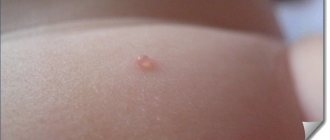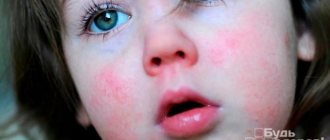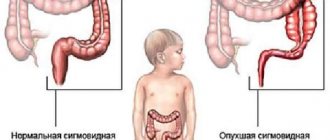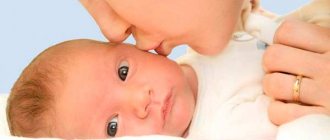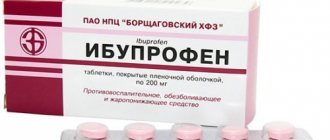Disruption of healthy intestinal microflora is a common problem in newborns. Dysbacteriosis in infants is accompanied by upset stool, repeated regurgitation, abdominal pain and bloating. Timely treatment allows you to avoid aggravation of the condition and the development of serious pathologies of the digestive system.
Dysbacteriosis is not a disease and if such a diagnosis is made, do not be alarmed ahead of time
Causes of dysbiosis in an infant
In newborn babies, intestinal problems are more likely to occur due to a lack of beneficial bacteria. This is a transient dysbacteriosis - the colonization of bifidobacteria and the displacement of the pathogenic environment. The physiological process lasts from the moment of birth until 10-15 days of life.
In the first month of life, the gastrointestinal tract is just forming and stool upset or lack thereof, regurgitation, colic in a one-month-old baby are a consequence of the immaturity of the mucous membranes of the digestive organs.
Children under one year old suffer from dysbiosis for reasons such as:
- improperly selected nutrition - frequent changes in formula, early complementary feeding, abuse of dairy products for lactose intolerance;
- antibacterial therapy – after taking antibiotics, negative changes occur in the intestinal microflora, since the drugs have a detrimental effect not only on pathogenic microorganisms, but also on healthy bacteria;
- infectious diseases - rotavirus, salmonellosis, dysentery;
- helminth infestations , giardiasis.
The first cause of dysbiosis is unhealthy diet.
Important! Dysbacteriosis in a breastfed child is much less common than when feeding formula. This is explained by the fact that with mother's milk the baby receives immunoglobulin and healthy microorganisms. The cause of watery stools, regurgitation and colic in the first 3-5 days is the presence of harmful cells in the body, which are replaced by healthy microflora within 7-10 days.
Sample collection
It is possible to increase the information content of analyzes through careful preparation for their delivery.
3-5 days before collecting fecal material, exclude meat purees and broths, stop introducing new products into complementary foods. It is also recommended to suspend courses of medications (antibiotics, prebiotics, digestive enzymes, sorbents), laxative suppositories, and cleansing enemas. If you are constantly taking medications or otherwise cannot be discontinued, you should inform your doctor about them in advance.
Immediately before the analysis, you need to let the baby empty his bladder and wash it thoroughly. This manipulation will prevent urine impurities from getting into the stool. Remove the diaper in advance and place the child on a clean diaper or oilcloth.
For reference! A massage with bending your legs towards your stomach and circular stroking will help speed up the process of bowel movement. You can also use a gas outlet tube. The sterile device is lubricated with Vaseline without impurities, carefully inserted into the anus by 0.5-1 cm. A bowel movement should occur within 5 minutes.
The container is taken sterile. Pharmacies sell special jars with a scoop and a lid. 8-10 g of feces are placed in a container and delivered to the laboratory no later than 3 hours after collection. In cases of delay or heat, the material is placed in a cool bag or chamber for up to 6 hours.
If difficulties arise in such manipulations, you can contact the clinic for help.
Symptoms of dysbiosis in infants
An imbalance of healthy and pathogenic bacteria in the intestinal mucosa is always accompanied by a pronounced clinical picture.
Table “Manifestations of dysbiosis in infants”
| Sign | Characteristic |
| Chair | Frequent diarrhea (less often constipation). Remains of undigested food, lumps of mucus, and grains of curd are visible in the stool. Putrid smell of feces |
| Regurgitation | The baby often burps profusely and feels nauseous, which often ends in vomiting. |
| Skin rash | A small rash appears on the body (urticaria, atopic dermatitis), the skin turns red, peels, and diaper rash develops |
| Appetite | The child eats poorly, interest in food disappears |
| Weight | The baby is gaining little or no weight gain at all |
| Discomfort in the abdomen | Newborns experience pain, colic, and difficulty passing gas, which is manifested by a feeling of fullness in the abdomen, heaviness. |
| Changes in the oral cavity | The child develops a dark plaque on his teeth, his gums bleed and hurt. The smell from the mouth is unpleasant. There is a white or gray coating on the tongue |
Frequent regurgitation often indicates gastrointestinal problems
As the problem worsens, infants' hair splits and falls out, nails peel off, and the skin on the face and body turns pale (seen in the photo).
Dysbacteriosis can cause hair loss
Pale skin is a sign of gastrointestinal problems
When is an examination necessary?
An attentive parent always notices changes in the functioning of the child’s body. You should go to the doctor with suspected dysbiosis if 2 or more symptoms from the following list are detected:
- flatulence, difficulty passing gas, bloated tummy;
- frequent loose stools;
- frequent constipation;
- fecal matter with admixtures of mucus, green or blood streaks, lumps, foam;
- excessive frequent regurgitation of curdled milk;
- allergy to milk or formula;
- skin rashes and spots;
- frequent colds or other manifestations of weak immunity;
- pale skin;
- frequent colic;
- dry skin;
- stomatitis, fungal infections in the oral cavity;
- vomit.
In addition, against the background of symptoms, a general change in the baby’s condition is noted. The child becomes whiny, lethargic, often irritated by ordinary activities around him, sleeps poorly, eats poorly, and gains little weight.
In the first days of introducing complementary foods, similar symptoms may be observed. In such cases, the functioning of the gastrointestinal tract is normalized without outside intervention. This condition can be distinguished by the duration of symptoms and impurities in the stool. New food takes root in no more than 2-3 days.
During complementary feeding, there are small amounts of foam, pieces of food, and mucus in the stool, but there are no blood streaks or abundant greenery. The alarm should be sounded if defecation occurs more than 10-12 times a day with screaming, noticeable difficulty and discomfort. Normally, liquid stool gradually changes to semi-solid stool.
If dysbacteriosis is suspected, the doctor will immediately prescribe tests. Correct decoding will help prevent deterioration in the baby’s health in time.
Degrees of dysbacteriosis
The severity of dysbiosis in infants has several degrees and depends on the quantitative and species composition of the intestinal microflora.
- 1st degree – anaerobic (normal) environment, the basis of which is lacto- and bifidobacteria (not less than 105-109). The presence of opportunistic microorganisms is allowed (up to 104 CFU in 1 g of feces), but no more than 2 types.
- 2nd degree – the ratio of aerobic (typical for pathogenic cells) and normal flora is 50:50. Replacement of E. Coli (common Escherichia coli) by pathogenic strains is observed; lactose-negative and hemolyzing enterobacteria are increased, their concentration reaches 108 CFU/g and more.
- 3rd degree - lactic acid bacteria are significantly reduced, opportunistic microorganisms replace healthy flora. The aerobic environment occupies most of the microflora.
- 4th degree – complete displacement of healthy microflora. Opportunistic bacteria are highly resistant to antibiotics. Acute intestinal infections develop, and sepsis is possible.
Degree of dysbacteriosis with the number of bacteria
The initial stage does not require special treatment. It is enough to adjust the diet of the child or mother (if breastfeeding).
What tests to take
Testing for dysbacteriosis is carried out using laboratory methods. Your doctor may suggest one or more of the following tests:
- coprogram. Diagnosis of feces for the degree of digestibility of food, signs of inflammatory processes (mucus, leukocytes). Also, in parallel, a review is carried out for the presence of worm eggs and their cysts. The microflora is examined by shape, movement, presence of legs and flagella. It is carried out using a microscope in 1 day;
- biochemical stool culture for opportunistic bacteria. A certain amount of organic acids is released into the masses. After this, they look at the reactions and concentration of the products produced. Based on the isolated fatty acids (propionic, butyric, acetic) they see which organisms are more numerous. Study duration: up to 5 days depending on the equipment. Preliminary results can be found out in a day;
- seeding for drug resistance. If there are a large number of certain bacteria, an additional test for reaction to antibiotics may be prescribed in order to select the appropriate treatment.
Apart from drawing up a clinical picture of the child’s condition, these tests are rarely informative. It is important to combine different types of diagnostics.
Diagnostics
An analysis for dysbacteriosis - stool culture - helps to recognize an imbalance in the intestinal microflora. The material is submitted in the morning, feces are collected in accordance with the requirements of the laboratory. The study makes it possible to determine the types of pathogenic bacteria and their sensitivity to specific antibiotics.
Additionally, a biochemical stool test is prescribed. With its help, the degree of damage to the intestinal mucosa and the level of volatile fatty acid metabolites produced by pathogenic microorganisms are determined.
Instrumental diagnostic methods and additional tests help determine the cause of dysbiosis:
To diagnose dysbiosis, a number of studies are carried out, including ultrasound of the abdominal cavity
- gastroscopy;
- Ultrasound of the peritoneal organs;
- stool analysis for the presence of worms and lamblia;
- liver tests.
Important! Comprehensive diagnostics makes it possible to accurately diagnose dysbiosis, excluding ulcerative colitis, acute intestinal infection, and identify the source of the pathological condition. A specialist deciphers the analysis.
Treatment of bacteriosis in infants
In case of dysbacteriosis, the child’s nutrition plays an important role:
- when breastfeeding, try not to switch the baby to formula for as long as possible;
- when artificial feeding, choose a mixture that contains lacto- and bifidobacteria.
It is possible to cure dysbiosis if you choose the right therapy. Several groups of drugs help eliminate pathogens and restore the intestinal microflora in a child.
- Bacteriophages - remove pathogenic flora - Intestifage.
- Probiotics - contain healthy bacteria - Enterol, Acipol, Linex, Hilak-forte, Bifiliz.
- Prebiotics - stimulate the growth of lactic acid bacteria - Duphalac, Inulin, Lactulose.
To replenish beneficial bacteria in the intestines, you can take Hilak-Forte
Immunostimulating agents – Anaferon, Polyoxidonium, Amiksin – strengthen the immune system weakened by the disease. All medications are selected individually, taking into account the characteristics of the body and the severity of the disease.
Why is dysbacteriosis dangerous?
An imbalance of healthy and pathogenic bacteria in the intestinal microflora is a serious deviation, the untreated of which is dangerous for the development of complications:
- the functioning of internal organs is disrupted;
- processes of decay in the intestines provoke acute intoxication of the body;
- increased susceptibility to allergic diseases;
- immunity decreases, which leads to frequent colds;
- sleep is disturbed, irritability and moodiness appear;
- there is a developmental delay.
Important! Prolonged ignorance of dysbacteriosis or its incorrect treatment can aggravate the child’s condition and complicate the recovery process.
What the analysis will show
Laboratory studies show the microbial composition of feces. Based on the result, they speak about the state of the microflora at the moment. Diagnostics allows us to draw generalized conclusions. Dysbacteriosis or its absence can only be judged by summarizing the tests and collected data on symptoms.
Stool examination takes up to 1 week for certain reasons. The material is first placed in a fungal growth environment. Decoding begins when growth becomes sufficient for visual inspection under a microscope.
The final document will indicate 4 main positions:
- bifidobacteria. They are responsible for the breakdown of carbohydrates, fats, proteins, and the absorption of elements in the intestines. Without them, stimulation of gastrointestinal motility does not occur, and minerals and vitamins are not synthesized. Bifidobacteria also neutralize pathogenic fungi and poisons;
- lactobacilli. They produce lactic acid, maintain acid-base balance, synthesize enzymes, lactase, and fight infections. With their acute shortage, stool passage is disrupted, food intolerance and allergies occur;
- Escherichia. They digest food, destroy toxic elements, remove excess oxygen, and help the immune system. The number of Escherichia decreases in the presence of harmful parasites and infections;
- bacteroides. Breaks down excess fat cells. It is believed that with optimal metabolism, children under six months should not have them.
Results are measured in colony forming units per gram of drug per gram of feces - CFU/g.
Table. Normal indicators
| Name | Quantity |
| Enterobacteria pathogenesis | none |
| Bifidobacteria | From 100 (for children over 1 year – above 108) million/year |
| Lactobacilli | From 106 (for children over 1 year - above 108) million/year |
| Escherichia (E. coli of normal activity) | 300-400 million/year |
| E. coli reduced activity | No more than 10% |
| General presence of E. coli | 108 million/year |
| Coccal forms in general content | 107 million/year |
| Hemolyzing flora | absent |
| Candida mushrooms | Up to 103 million/year |
| Staphylococcus | Up to 104 million/year |
| Citrobacter, Klebsiella, Proteus, Clostridia, etc. | Up to 105 million/year |
| Yeast | Up to 1000 million/year |
Indicators of deviation from the norm
Deviations in indicators indicate dysbiosis with a risk of developing concomitant diseases:
- enterobacteria pathogenesis. Their presence indicates the onset of an intestinal infection. The higher the quantity, the closer to the acute stage of salmonella, shigella, and dysentery. Treatment should begin immediately;
- bifidobacteria. A small amount indicates weak resistance to diseases, the development of inflammatory processes in the gastrointestinal tract and the rest of the body;
- lactobacilli. The deficiency also signals a violation of the body’s immune defense and the possible presence of viral infections;
- Escherichia, Escherichia coli. A general deficiency or excess is a sign of the microflora’s inability to synthesize vitamins correctly. A low number of Escherichia is also often accompanied by the presence of parasites and their cysts in the intestines;
- hemolyzing flora. The presence leads to poisoning of the body. Often speaks of infection with a toxic substance (harmful E. coli) from animal food. Interferes with digestion, provokes allergies, colic, defecation disorders;
- staphylococci. Excess (especially the golden type) increases bowel movements, leads to exhaustion of the body, and seriously disrupts metabolic processes. Enters by airborne droplets, usually with milk. Dangerous for the child, requires immediate treatment;
- candida. Excess appears more often after antibiotic therapy. It manifests itself as thrush of the mucous membranes, bloating, stool disorders, and intestinal pain. Suppresses the proper microflora of the gastrointestinal tract, disrupts food digestion;
- Proteus, Citrobacter, Klebsiella and other lactonegative bacteria. Above normal levels cause intestinal irritation, regurgitation, and prevent food from being absorbed;
- bacteroides. The presence in an infant may indicate improper breakdown of food, lack of fats for the structure of cells of a growing body.
An exact explanation can only be given by a doctor.
Prevention of dysbiosis in infants
Simple preventive measures can help protect your child from unpleasant intestinal problems.
Breastfeeding is one of the main guarantees of good future health for the baby.
- Give preference to breastfeeding, while mothers strictly monitor their own nutrition.
- If breastfeeding is not possible, carefully select formulas, using those that contain pre- and probiotics. Try to use one type of mixture.
- Do not introduce complementary foods too early. Normally, the first acquaintance with adult food occurs at 6 months.
- Monitor your baby’s health, lead a healthy lifestyle, and undergo preventive medical examinations on time.
Prevention allows you to prevent the development of dysbiosis or eliminate it in the early stages of development. The disease is much easier to prevent than to cure.
Diet of a nursing mother for constipation in a child
Often, young mothers try to find a special diet for themselves so that their babies do not have constipation. But let's try to find out whether the diet of a nursing mother affects constipation of the baby? Constipation is the name given to babies' hard and painful stool (like smoked sausage or sheep's balls), which can be either rare or regular. Infants practically do not experience constipation as such; they are characterized by a state of physiologically rare stool. Due to its unique composition, the absorption of breast milk can be so complete that virtually no waste remains. Therefore, children can walk in a big way not even every day, but once every few days. The stool is just as loose, mushy and large in volume.
Diet of a nursing mother for constipation in a baby
The nutrition of a nursing mother with constipated infants does not undergo any special changes. You need to eat a nutritious and varied diet, and you should consume more liquid so that your baby gets enough fluid through breast milk. You should not abuse laxative foods - prunes, dried apricots and other laxative substances. They can cause a negative reaction from both the digestion of the mother and the baby.
